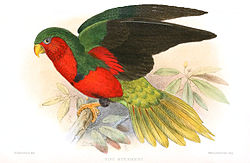Description
The lorikeets are 19 cm (7.5 in) in length and weigh 42–55 g (1.5–1.9 oz).
Adults are green on the upper side, with a green occiput and crown. The green color turns into a yellow-green at the base and tail. They have a green underwings, with a green band across the chest that varies in appearance. Their breast is red in color, and turns purple towards their abdomen and thighs. They have a deep orange beak with yellow or orange eyes. [3]
Juvenile Stephen's lorikeets have green underparts with purple or red marks on their throats and abdomens. Their tail tends to be a dark green. They have brown beaks and eyes. [3]
The calls emitted while feeding are soft and twittering. The call made while in flight are louder. [3]
Behavior and ecology
The lorikeets are hard to spot in dense foliage. They are generally found in small groups or flocks. They are known to travel between the inland foliage and coastal palms to feed on coconuts. [3]
Reproduction
Their breeding season is thought to be around April or the start of May. [3]
Threats
The lorikeets are assessed as vulnerable by the IUCN. They are thought to have a stable population of 720-1,820 individuals. Due to their extremely limited range, the main threat to the survival of the lorikeets is the accidental introduction of predators to Henderson Island and habitat loss due to deforestation or natural disasters. They, however, seem to have adjusted to the introduction of at least one invasive predator, the Polynesian rat. There has been an unsuccessful attempt to eradicate invasive rodents from Henderson Island. [3] [5]
This page is based on this
Wikipedia article Text is available under the
CC BY-SA 4.0 license; additional terms may apply.
Images, videos and audio are available under their respective licenses.

